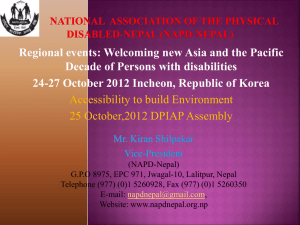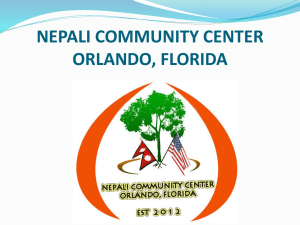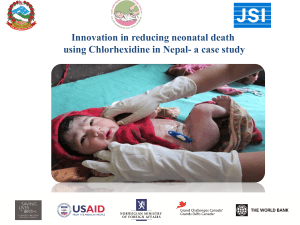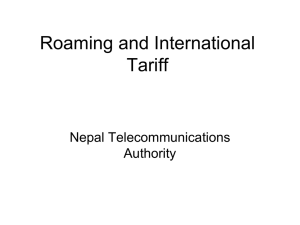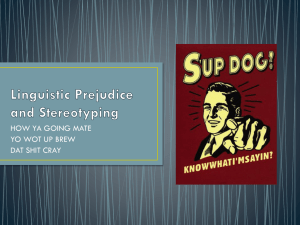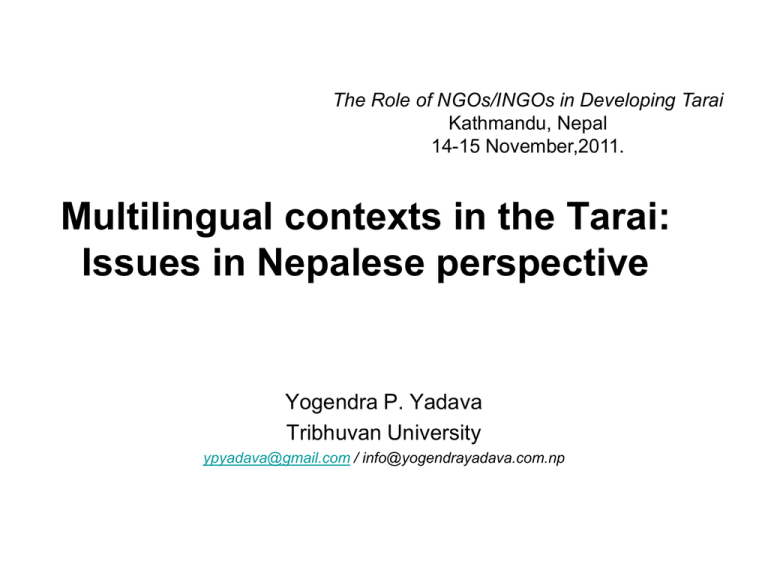
The Role of NGOs/INGOs in Developing Tarai
Kathmandu, Nepal
14-15 November,2011.
Multilingual contexts in the Tarai:
Issues in Nepalese perspective
Yogendra P. Yadava
Tribhuvan University
ypyadava@gmail.com / info@yogendrayadava.com.np
Outline
Nepal is characterized by rich linguistic diversity.
The Tarai, inhabited by half of Nepal's total population (viz.
50.15%, CBS 2011), is more or less not immune from this
characteristics.
Goal: an attempt to analyze the overall state-of the-art situation
of the languages spoken in the Terai.
Specific objectives:
i. sociolinguistic aspects (identification, genetic affiliation,
distribution, literate traditions, language use in various
domains such as administration, education and media,
and language endangerment)
ii. issues related to the Tarai languages mainly from the
perspectives of their
linguistic
inclusion .
1
2
1. Background
Languages, being living and dynamic, naturally
have
to
undergo
constant
change.
Consequently, it is difficult to enumerate the
precise number of the world's living languages.
However, Ethnologue (2009) has made an
approximation of 6,909 languages spoken all
over the globe. With the growing awareness of
knowledge of these languages, the number of
languages in use has been increasing on the
one hand while, on the other, a considerable
number of languages are going out of use
(Krauss 1992).
1
3
South Asia, like the world's several countries, is
'a rich and fascinating linguistic area' with
several hundred languages from four major
language families, viz. the Indo-European (ca.
74%), the Dravidian (ca. 24%), the
Austroasiatic (ca. 1.2%), or the Sino-Tibetan
(ca. 0.6%) families, with some unclassified
language isolates (such as Kusunda) in the
Himalayan
region
(http://en.wikipedia.org/wiki/Languages_of_Sout
h_Asia).
1
4
Nepal comprises a relatively small area of 147,181
square kilometres with a length of 885 kilometres from
east to west and a mean breadth of 193 kilometres
from north to south. However, its topography is rich
and varied. Inhabiting the different climatic and
ecological zones with a high level of biodiversity per
unit area, it is matched by a similar rate of linguistic
and cultural variation. Nepal is populated by 103
officially recognized caste and ethnic groups who are
largely Hindus, Buddhists, Animists, Muslims, and in
some cases a combination of two or more of these
(Pradhan and Shreshtha 2005) and speak around 92
languages officially-recognized by the state (Yadava
2003; Yadava and Turin 2007).
1
5
1
6
2. The Tarai languages
• tease out the major aspects of the language
situation in the Tarai. These aspects include:
• identification,
• genetic affiliation,
• distribution,
• nomenclature,
• written traditions,
• multilingualism,
• language resources,
• domains of language use,
and so on.
1
7
2.1 Identification
•
•
•
•
•
•
•
•
•
•
•
•
•
•
•
•
•
S.No. Languages
1
Maithili
2.
Bhojpuri
3.
Tharu
4.
Avadhi
5.
Bajjika
6.
Urdu
7.
Rajbanshi
8.
Hindi
9.
Santhali
10
Uranw
11. Bangla
12. Marwari
13. Dhimal
14. Angika
15. Meche
16. Khariya
17. Kisan
18. Koche
19. Magahi
No of speakers
2797582
1712536
1331546
560744
237947
174840
129829
105765
40260
28615
23602
22637
17308
15892
3301
3301
489
54
30
1
%
12.30
7.53
5.86
2.47
1.05
0.77
0.57
0.47
0.18
0.13
0.10
0.10
0.08
0.07
0.01
0.01
0.00
0.00
0.00
8
Of these Tarai languages, Maithili, Bhojpuri,
Tharu, Avadhi, Bangla, Dhimal, Hindi,
Uranw/Jhangar/Dhangar, Marwari, Rajbanshi,
Santhali, and Urdu have been consistently
reported in the various censuses since 1952/54.
Some of the languages such as Meche have
been reported irregularly. Five of the Tarai
languages (viz. Angika, Bajjika, Khariya, Shadri
(Kisan), and Koche) have been reported only in
the census 2001 for the first
time.
1
9
• Angika and Bajjika, which were earlier considered the
dialects of Maithili and Bhojpuri, respectively, have
been returned as distinct languages in the 2001
census. The enumeration of the Tarai languages
shows variation in different censuses. Similarly, Tharu
has been enumerated in various censuses but it also
needs to be analyzed to ascertain whether it is a
single language with several regional dialects or
comprises more than one language. While the Census
2001 and other estimates have established fairly
credible numbers of the Tarai languages, more
precise and accurate figures still need to be
ascertained through further careful investigation.
1
10
• Similarly, Census 2001 does not distinguish Dagaura Tharu
from Rana Tharu, a distinct language. In addition, with growing
democratic awareness people have been asserting for
recognizing a few minority languages such as Tajpuriya,
Kushwadiya, etc. We can obtain a precise identification of the
Tarai languages only through their scientific survey (See
Yadava and Turin (2007) for a similar observation on the
languages spoken in Nepal as a whole).
• With the growing democratization and awareness among
Nepalese people in recent times several communities have
been asserting for their ethnic and linguistic identity. In Tarai,
for example, minority communities such as Tajpuriya,
Pattharkatta, and Sonama have come up with their demand for
recognizing their ethnic and linguistic identity. Similarly, some
community zealots have wrongly claimed to speak languages
like Musasa and the like.
•
1
11
2.2
1.2 Genetic affiliation
Language families:
1. Indo-European -15
2. Sino-Tibetan -2
3. Austro-Asiatic -1
4. Dravidian- 1
1
12
• 2.3
Distribution
Most of the Tarai languages are cross-border and
trans-regional languages as they are spoken in Nepal
and India and also in the Tarai and the Hills.
1
13
1.2
affiliation
2.4Genetic
Nomenclature
The Tarai languages are found to be named in various ways. The
names for several languages have been derived from the country
or place names and bestowed by the-then ruling classes as their
official names. Such regional designations have gradually gained
currency among their users and others. One of such languages is,
like Nepali, Maithili, which had been established as the state
language of the Kingdom of Mithila. Its main alternative names
include Tirhutiyaa, Dehaati, etc. Other languages of Nepal whose
nomenclature is based on place names are Bhojpuri (< Bhojpur),
Awadhi (<Awadh), Hindi (<Hindustaan), Santhali (<Santhal),
Bangala (<Bangaal), Marwadi (Mawaad), Angika (<Ang), Meche
(<Mechi), Punjabi (Punjab), Oriya (<Orissa), Sindhi (<Sindh),
Marwari (< Marwar), Hariyanvi (<Hariyana,), Magahi (<Magadh),
Assamese (<Assam), etc.
1
14
• Secondly, there are a few examples in Nepal of a
language name derived from a community or tribe
name. Such languages include Tharu, Rajbanshi,
Dhimal, Khariya, Shadri, Dhangar/Jhangar/Uranw,
Munda, etc.
• Thirdly, Urdu and Sanskrit are the two languages
which are very much restricted to religions. Urdu,
originated as Dakshni (the ‘southern’ language) used
by the Muslim conquerors in northern Deccan and
later called Urdu, the language of the court, called the
Horde, in the main stronghold of Northern Hindustan,
was finally adopted as the language of the Muslim
community in India as well as Nepal ( Cf. Breton,
1997:74) .
1
15
• Sanskrit, enumerated only with 823 native
speakers, is hardly used as a medium of
mass communication but it has been
actively used by Hindus in performing their
religious rituals and also by scholars in
scholastic studies and deliberations.
• Finally, Nepali Sign Language, which has
been reported in the 2001 census for the
first time, has been named after the
medium or ‘signs’ used by the deaf in their
communication.
1
16
• It may, however, be noted that this sign language is
obviously different from the one spoken in the Tarai
which, therefore, needs to be identified separately.
• There are quite a few languages with more than one
name, e.g. Tirhutiya and Dehati for Maithili6.
Etymologically, the derivation of an Indo-Aryan
language name may involve a productive adjectival
Nepali suffix –i attached to a nominal stem
(indicating place), e.g. Mithila + -i = Maithili, Bhojpur
+ -i + = Bhojpuri, Awadh + -i = Awadhi, etc. The
Tibeto-Burman languages, however, do not involve
such suffixation, e.g. Dhimal (but not Dhimali) . 6 See
Grimes (2000) for the various names used for a
language.
1
17
4.42.5
Literacy
Literacy
in languages
in the Tarai languages
Most of the languages spoken in Nepal are still confined to their
Some existing scripts:
i. Devanagari:
ii. Mithilakshar/Tirhuta:
iii.Gurumukhi:
iv.Perso-Arabic:
v. Ol Ciki /Ol:
vi.Bengali:
1
Maithili, Bhojpuri,
Avadhi, Rajbanshi
Maithili
Punjabi
Urdu
Santhali
Bengali
18
• Most of the Tarai languages, which are crossborder languages spoken in both Nepal and
India, have well-developed literate traditions.
They include Maithili, Bhojpuri, Avadhi, Hindi,
Assamese, Bangla, Urdu, Punjabi, Santhali, and
Marwadi in particular. All of them have long
tradition of written literature. These languages
have employed various writing systems or
scripts. Most of the Indo-Aryan languages such
as Maithili (originally written in Mithilakshar or
Kaithi script), Bhojpuri, Awadhi, Hindi and
Rajbanshi are written in the modern Devanagari
script with small adjustments and additional
letters.
1
19
• The modern Devanagari script has evolved
from an ancient writing system, called Brahmi
dating back to about 500 BC. Though Bangala
is written in a modern Bengali script, which
developed from the Kutila variety of the
northern type of the Brahmi script. The protoBengali script degenerated into Maithili Tirhuta
script or Mithilakshar and Kaithi with small
adjustments
and
additional
characters.
Another script Perso-Arabic is used in writing
Urdu language while Punjabi language is
written in Gurumukhi.
1
20
• As in India, Santhali in Nepal is written in
the Santali alphabet, which is also known
as Ol Cemet', Ol Ciki or simply Ol, which
was created in the 1920s by Pandit
Raghunath Murmu as part of his efforts to
promote Santali culture. Until the invention
of this alphabet, Santali was either not
written at all, or was written with the
Bengali or Oriya alphabets. Christian
missionaries prefer to write Santali with
the Latin alphabet. In Nepal some people
also write Santhali in Devanagari.
1
21
2.6 Multilingualism
• The linguistic diversity existing in the
country has given rise to the three
situations
in
the
country,
viz.
monolingualism,
bilingualism,
and
multilingualism.
Of
these
language
situations, only monolingualism or the use
of just mother tongues has been regularly
reported since the first modern census in
1952/54.
1
22
• Most speakers of Nepal’s languages have
been found to be in close contact. As a
result, these languages tend to converge
through mutual borrowing and influences
and gradually share a number of lexical
and grammatical features. For example,
we find Tibeto-Burman languages “IndoAryanized” and Indo-Aryan languages
“Tibeto-Burmanized”. There is a need for
an intensive study of convergence as well
as divergence to ascertain the precise
1
23
nature of Nepal as a linguistic area.
• The Indo-Aryan languages spoken in the
Tarai (e.g. Rajbanshi, Maithili, Bhojpuri,
Avadhi, and Tharu) constitute a curious
case,
in
that
they
are
linked
uninterruptedly from the viewpoint of
intelligibility. That is to say, it is rather
difficult to say where one language ends
and another begins. However, the degree
of intelligibility goes on decreasing with the
increase in distance between the adjacent
languages. In such a case, people adopt
Hindi as a link language. Thus, these
1
24
languages form a continuum.
2.7 Language resources
Language Resources
(n=58)
Newspaper
Magazine
5% 5% 5%
Journal
10%
13%
Learning Material
Literacy Material
6%
Literature
7%
Poems
16%
Plays
6%
10%
8%
Fictions (Short stories, Novels)
9%
Folk Songs (CD/Cassettes)
Telefilm
1
Film
25
1.4 Language attitudes
2.8
Feeling Prestigious
n=58
3%
Yes
No response
97%
1
26
2.9 Domains of language use
2.9.1 Administration
1 International Instruments
Many international and regional human rights
documents (instruments) regulate the right to
education in relation to language. Most demand “only”
that nobody should be discriminated against on the
basis of language.
All these and many more can be found on the website
of the Office of the United Nations High Commissioner
of
Human
Rights
(http://www.ohchr.org/EN/Pages/WelcomePage.aspx).
1
27
2
National language-related legal framework
The Interim Constitution of Nepal 2007
incorporates the following provisions regarding
language and language rights:
Article 5. Language of the Nation:
Sub-Article (1). All the languages spoken as the
mother tongue in Nepal are the national languages of
Nepal.
Sub-Article (2). The Nepali Language in Devnagari script
shall be the official language.
Sub-Article (3). Notwithstanding anything contained in
clause (2), it shall not be deemed to have hindered the
use of the mother tongue in local bodies and offices.
State shall get the languages so used translated into an
official working language and maintain record thereof.
1
28
Article 13. Right to Equality:
Sub-Article (2). No discrimination shall be made against any
citizen in the application of general laws on grounds of religion,
race, sex, caste, tribe, origin, language or ideological conviction
or any of these.
Sub-Article (3).The State shall not discriminate among citizens
on grounds of religion, race, caste, tribe, sex, origin, language
or ideological conviction or any of these. Provided that nothing
shall be deemed to prevent the making of special provisions by
law for the protection, empowerment or advancement of the
interests of women, Dalit, indigenous ethnic tribes, Madeshi, or
peasants, labourers or those who belong to a class which is
economically, socially or culturally backward and children, the
aged, disabled and those who are physically or mentally
incapacitated.
1
29
2.9 Domains of language use
2.9.2 Education and media
• Quite recently, The Interim Constitution of Nepal
(2007), an outcome of the Andolan II, makes the
following provisions for languages:
• Regarding the education and cultural right, the
constitution enshrines the following provisions:
• (1) Each community shall have the right to get basic
education in their mother tongue as provided for in the
law.
• (3) Each community residing in Nepal shall have the
right to preserve and promote its language, script,
culture, cultural civility and1 heritage.
30
• Awadhi, Bhojpuri, Maithili, Tharu, and
Rajbanshi languages were reported to be
used as medium of study and/or as a
subject of study in elementary education
whereas Hindi and Maithili were reported
to be used in higher education.
• Of all the Tarai languages, Avadhi,
Bhojpuri,
Dhimal,
Hindi,
Maithili,
Rajbanshi, Tharu, and Urdu have access
to publication of newspapers and/or
magazines related to news, literature,
culture and language activities.
1
31
2.10Language not as ‘isolated units’
4.3 Languages are not ‘isolated units’
Misconception: Each language, culture and
religion is like an isolated unit.
Illustrated in Figure 1
(Watters 2008)
1
32
However, languages are not isolated units. In fact,
they can be inter-related to one another in a number
of different ways, including through a common
linguistic history, or culture, or perhaps through
economic ties or social ties such as inter-marriage
(Watters 2008).
Illustrated in Figure 2.
1
(Watters 2008)
33
The Indo-Aryan languages spoken in the Tarai (e.g.
Rajbanshi, Maithili, Bhojpuri, Avadhi, and Tharu) constitute
a curious case of language continuum, in that they are
linked uninterruptedly from the viewpoint of intelligibility
(Yadava et al. 1995). That is to say, it is rather difficult to say
where one language ends and another
begins.
However, the degree of intelligibility goes on decreasing
with the increasing distance between the adjacent
languages. Thus, these languages form a continuum.
In such a case, people employ a language of wider
communication or contact language, e.g. Hindi in the Tarai,
Sherpa (or Tibetan?) in the mountains, Bantawa in the RaiKirat region, Nepali in the hills, and so forth.
Thus, languages constitute various clusters which may be
considered for state restructuring on linguistic basis.
1
34
2.10
•
•
•
Unknown diversity
Nepal is impressively diverse in its linguistic makeup. The
diversity is known – known to exist – but the way in which it
is diverse, the extent to which it is diverse, is not fully known.
Language relationships in the Himalayan region are
exceedingly complex, and there is little agreement about
what the higher-order taxonomic relationships really are. Is
Newar Bodish or is it Himalayish? Where does Chepang
fall? Is Ghale part of the Tamangic complex or not? People
have come and gone, kingdoms have risen and fallen, and
influences have ebbed and flowed. Tibeto-Burman, IndoAryan, and Munda languages (among others) have been
spoken within close proximity to one another for many
hundreds, if not thousands, of years, and each has exerted
lexical and grammatical influence on their neighbors. In
some cases, what may have originally been genetically
distinct languages have, over time, come to be typologically
similar because of linguistic convergence.(LinSuN 2008)
Language/dialect controversy
1
35
3. Major Linguistic issues
• This paper has presented the current profile of the
languages spoken in the Tarai. The following are its
major issues which need to taken into consideration in
the contexts of formulating an inclusive language
policy for state restrucuring, choice of official
language(s), medium/subject of instruction in school
education, and language use in media and legal
transactions to be enshrined in the forthcoming
constitution :
1. In the lack of adequate studies about several Tarai languages it
is difficult to understand precise genetic relationships among
them.
2. All the Tarai language names1 do not represent their speakers'
36
attitude.
3.
4.
5.
There exists no satisfactory account of
information about regional, social and
stylistic varieties of the Tarai languages
in Nepal. It is, therefore, difficult to
determine their dialectal variations.
In most of the language there are no
writing systems and they are confined
to their oral traditions. It is necessary to
develop appropriate writing systems for
the unwritten Tarai languages.
There has been no standardization of
the Tarai languages except Hindi.
1
37
6. As for the domains of languageuse,
the
following observations have been made in
this study:
a. Nepali alone has been used in
administration
and
other
language
communities have remained excluded.
b. There are 19 mother tongues used in
primary education as a subject. It is
necessary to introduce other languages
both as subject and medium.
c. There has been recent thrust on
introducing quite a few languages in
media.
1
38
d. Nepali has been mostly used a
language of wider communication in
the hills and the mountains but it is
Hindi in the Terai.
e. Most of the language communities
have expressed interest in preserving
and promoting their mother tongues.
f. Most speakers have positive attitude
towards their mother tongues.
g. Most of these languages are more or
less threatened with extinction and
need to be revitalized and promoted.
1
39
7. Languages are not isolated units. In fact,
they can be inter-related to one another in
a number of different ways, including
through a common linguistic history, or
culture, or perhaps through economic ties
or social ties such as inter-marriage.
8. An intensive study of the Tarai languages
needs to be undertaken for obtaining a
clear linguistic scenario in the Tarai as it is
inevitable for demarcating provinces on
linguistic basis and language use in
domains such as administration and
education.
1
40
Thank you !
1
41


